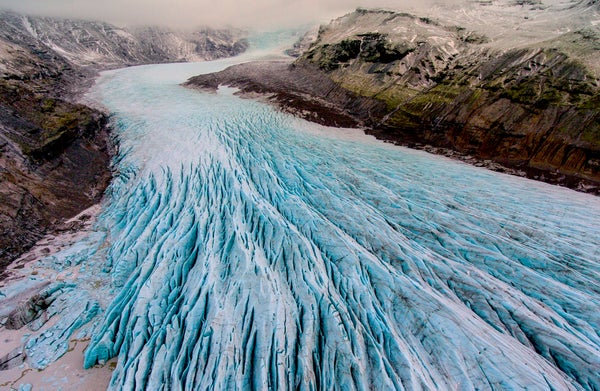Green Energy Is Getting a Boost from Iceland’s Melting Ice
Iceland’s Ice Is Melting So Fast That It’s Boosting Hydropower
Melting glaciers are creating a green energy windfall in Iceland—but for how long?

CLIMATEWIRE | REYKJAVÍK, Iceland — Few countries can compete with Iceland when it comes to renewable energy. The island nation gets nearly 100 percent of its electric power from green sources, and Iceland has championed the use of both geothermal energy and hydroelectricity.
That makes the country a model for a world trying to fight climate change — which is ironic because Iceland’s electric grid is only going to get stronger as the world gets hotter.
The reason? Hydroelectricity. Or more specifically, melting glaciers.
On supporting science journalism
If you’re enjoying this article, consider supporting our award-winning journalism by subscribing. By purchasing a subscription you are helping to ensure the future of impactful stories about the discoveries and ideas shaping our world today.
Iceland gets more than 70 percent of its power from hydroelectric stations fed by glacial meltwaters. So as the Earth heats up and glaciers melt faster, hydroelectric stations will have more water to spin turbines and power the grid — a silver lining for a country mourning its glacial decline.
“When the glaciers melt, then it will be more production from hydro,” said Guðlaugur Þór Þórðarson, minister of the Environment, Energy and Climate, in an interview with E&E News. “We have everything to be the mecca of green energy, and that’s what we want to do.”
Climate change is already making a difference.
Nearly all of Iceland’s glaciers have been shedding mass since the 1990s, and that’s led to an increase in hydro inflow — a boost that the country’s power system “has been mostly able to utilize,” according to a report released by the European Union.
Locals see the potential, too.
“We are anticipating more for the next hundred years — more water flowing,” said Guðmundur Finnbogason, a project manager with Landsvirkjun, the national power company.
Hydro stations are “literally producing gold for us,” said Finnbogason during a tour of the Írafoss Power Station, which is about 30 miles from Iceland’s capital Reykjavík.
The boon in power, however, comes with two potential pitfalls.
The first is wasted energy. A group from the Arctic University of Norway cautioned that at-capacity stations were bypassing extra water and throwing away potential electricity.
Þórðarson, the energy minister, acknowledged the missed opportunity.
“We’ve got a bit complacent,” he said. “We haven’t done that much when it comes to both hydro and geothermal in the last 15, 20 years.”
But, he added, “now things are moving very fast.”
The national power company plans to build more turbines to capture the climate-driven water surplus. Glacial runoff is expected to peak in about 40 to 50 years.“We are doing investments to be able to harness this increase of flow from the glaciers,” said Landsvirkjun CEO Hörður Arnarson.The second — and more existential — problem for Iceland is what to do when its glaciers have melted away.The EU report warns that “almost no Icelandic glaciers will be left in 2200.”It’s a bleak long-term projection, but the expectation is matched by a second — and more optimistic — estimate.The Icelandic Meteorological Office projects that precipitation will increase by 1.2 percent to 4.3 percent by the middle of the century, largely due to the effects of climate change.So even if the glaciers disappear, “we can expect more water coming to the power plants than we did in the beginning,” said Arnarson, the Landsvirkjun CEO.But that wetter future is far from a given, and scientists caution it’s challenging to predict a 2200 climate more than 150 years away. Ocean currents that enhance precipitation in Iceland could be gone or significantly slowed by then, for example.The uncertainty is why Þórðarson wants Iceland to diversify its grid from hydro and geothermal reliance to include wind, and possibly solar, tidal and rain power.“If something happens, and it will happen in the near or distant future, then we always have a Plan B,” Þórðarson said. “We cannot put all the eggs in the same basket.”
Reprinted from E&E News with permission from POLITICO, LLC. Copyright 2024. E&E News provides essential news for energy and environment professionals.


